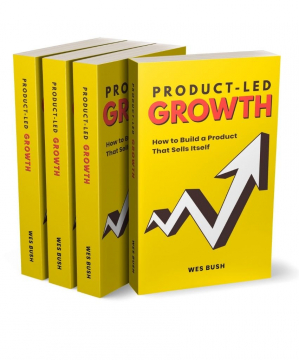Editor’s Note: This article covers one chapter from the book, “Product-Led Growth: How to Build a Product That Sells Itself,” written by Wes Bush, founder of Product-Led Institute.
If you can deliver on your value, and get consistently better at it, you’ll be able to build a world-class user onboarding machine that powers your business forward.
Now, you don’t have to be a genius to come to this conclusion on your own, but like many things in business, it’s easier said than done.
In this article, I’ll break down exactly what you need to do to deliver on your value in your onboarding experience. But before I dive in, I want to take a step back and address the root cause of bad user onboarding so we can avoid it.
When selling software. What we promise in our marketing and sales is the perceived value. What we deliver in our product is the experienced value. Ideally, the perceived value aligns perfectly with the experienced value.
Everyone is happy in this scenario—what we signed up for does exactly what we envisioned. But this is rarely the case. Most companies struggle with overpromising and under-delivering.
It’s one reason why product-led businesses are booming. People want to “try before they buy” and experience your value proposition. If you keep your word, it’s a great way to build trust and sell your product. If you fail to deliver, your user experiences a nasty value gap.
The bigger your value gap, the leakier your funnel. You’ll see users sign up but never return to your product. As you might remember from before, 40–60% of users who sign up for your product will use it once and never come back.
Tackling your value gap can be the single, most profitable lever you can pull. It will help you launch and build a free trial or freemium model that (actually) turns users into customers. There are three main reasons why value gaps are so prominent in the SaaS industry:
- Your product has serious ability debt;
- You don’t understand why your customers buy;
- You overpromise what the solution is capable of.
Eliminate Customer Confusion
Before launching a product-led arm of your business, declare war on your value gap. You’ll be in a much better position to create a product that can reduce your CACs, acquire more customers, and turn non-paying users into customers.
The Three Value Gaps You Need to Crush
Value Gap 1: Ability Debt
Ability debt is the price you pay every time your user fails to accomplish a key outcome in your product.
To chip away at your ability debt, you need to be ruthless about reducing friction. Even non-trivial steps like activation emails can crater your free-to-paid conversion rate.
Christopher Gimmer, the CEO of Snappa, initially required every new signup to activate their email address before logging into the product. Requiring users to activate their email address is standard practice. However, what Gimmer didn’t realize was that 27% of signups never activated their email. Users never saw the product.
In less than a week, Christopher’s team removed the email activation step. If Snappa’s current free-to-paid conversion rate held up, this one change would net a six-figure ARR outcome. When the results came in, they showed a 20% boost in MRR.
This is one of countless examples. But conquering ability debt will never go away. As Richard Kipp, CPO of Grow, notes, “You need to evolve your technology to a point where people can get hot and ready spaghetti without having to learn how to use the kitchen. As you remove pain and friction from your user’s experience of attaining their valued objective, your total addressable market grows.“
Now, even if you have a high-performing free trial or freemium model, you will inevitably have some ability debt. It’s expected. However, to improve your experience, you need to regularly ask yourself these questions while going through your product experience:
- Does the first product experience lead to a specific, relevant, meaningful “quick win”?
- Do tooltips and hotspots spur meaningful action in the product, not just point at buttons?
- Do social and directional cues indicate high-value behaviors?
- Are key task completions indicated with a success state, such as Mailchimp’s famous high-five?
- Are all unnecessary points of friction and distraction removed from critical workflows?
Each question helps you spot opportunities to reduce or eliminate ability debt. You can ask yourself infinite questions, but eventually, you need to talk to your customers. In Part III, we’ll dive deeper into how to reduce ability debt and help users experience your value proposition sooner. For now, get crystal clear on what you promise users when they sign up.
Value Gap 2: You Don’t Understand Why People Buy Your Product.
If you don’t know where someone wants to go, you can’t help them get there. Until you know what your users are trying to accomplish in your product, you’ll lead them to mountaintops they never wanted to climb.
Let’s say our friends at PayPal have a goal to generate 100,000 leads this month. The PayPal team might use Google Ads, Facebook, SEO, and remarketing to hit the lead target. Each marketing channel needs to get the PayPal team closer to hitting their lead generation outcome of 100,000 leads this month.
Since we understand the outcome of the PayPal team, we know that our product needs to help them generate leads. However, if we don’t understand the outcome PayPal is looking to solve for, what’s stopping us from forcing the PayPal team to set up a branding campaign?
Once we know the main outcome that our user is looking for, we can catapult them into the area of the product that is most relevant to them. Canva, a simple visual editor, does a brilliant job at shortcutting the time it takes to achieve a particular outcome in their product.
For instance, just type “how to make a poster” in Google and click on the Canva link. Once you click on the call to action, you’re directed to register for an account. Once you do, you’re immediately brought to the poster section of the product. In less than a minute, you’re able to select a poster from thousands of beautiful templates and edit the design you choose with ease.
When it comes to onboarding, most businesses walk you through the entire product but bring you no closer to achieving a meaningful outcome in the product. That isn’t too different than inviting your friends over to your house for dinner and, when they show up, you show them around the house but forget to give them anything to eat. Oops!
Although you might have a great house, your friends came for dinner. Same goes for your product. Although people come to your product and expect it to be neat and tidy, they’re really there for the main outcome. You need to give them something to sink their teeth into!
When you understand why people use your product, you can catapult them to the right destination. If you don’t know the primary outcome behind why people use your product, you’re growing your business on hard mode. What outcome does your product help people with? Is it lead generation? Is it getting more fit?
This may sound straightforward, but many businesses don’t know the main outcome that people want to achieve in their product. As a result, they unknowingly force unnecessary steps onto users during onboarding. It’s easy to do. If you don’t understand your product’s value, what’s stopping you from showing unnecessary features that might be helpful?
To reduce your value gap, set the right expectations.
Value Gap 3: You Suck At Communicating Your Value
If someone signs up for your product thinking that it’s a live-chat solution when it’s actually a telemarketing solution, you’re going to confuse users. Even if you’re clear on what your solution does, you can misinform users about how long it takes to do it—companies often promote how fast their solution gets results when, in reality, it takes a lot more time.
This hurts your brand and increases the chances of new users leaving your initial product experience. Delivering on your value and reducing your value gap starts and ends with helping people. There are no shortcuts or magic tools.
To nail your user onboarding, I want you to do three things:
1. Write down the key outcome(s) that someone wanted to accomplish.
Put this in a spreadsheet or somewhere you won’t lose it. Each time you onboard a new user, add to this list. Eventually, you’ll learn which outcomes are most important. If you’re looking for an “Aha!” moment, you’ll get it—in real time.
2. Focus on where you need to offer a helping hand.
If you use a tool for for user session playbacks, take special notes when users mess up. This is an opportunity for you to improve your product experience or add automated step-by-step guidance with a platform like WalkMe.
3. Lastly, clear the path.
You’re going to have garbage that prevents users from experiencing a key outcome in your product. When it comes to your onboarding, every step that doesn’t help your user experience a meaningful outcome should be removed.
Just like in the Snappa.com example I shared earlier—in which an email activation step kept 27% of new signups from ever logging in—you need to challenge each step. By removing the email activation step from the initial onboarding experience, Snappa boosted their MRR by 20%. Removing one unnecessary step from your onboarding may not have such a monumental impact, but it just might!
By focusing on helping your buyer become so successful using the product, upgrading to a paid plan becomes a no-brainer.
Personalize and Automate User Onboarding with WalkMe

Wesley Bush is the founder and president of the Product-Led Institute where he spends his days teaching SaaS businesses how to flip the traditional sales playbook and ignite their growth engine with the Product-Led Growth methodology. 
Want more than just a chapter? You can find Wesley’s book here.



![10 Questions with a Master Product Manager: Adam Long [Automated Insights]](https://product2market.walkme.com/wp-content/uploads/2018/12/Long-FB-of-Adam-Long-390x211.png)
![10 Questions with a Master Product Manager: Mik Lernout [Hootsuite]](https://product2market.walkme.com/wp-content/uploads/2018/11/Copy-of-Facebook-of-Large-Mik-Lernout-390x211.png)
